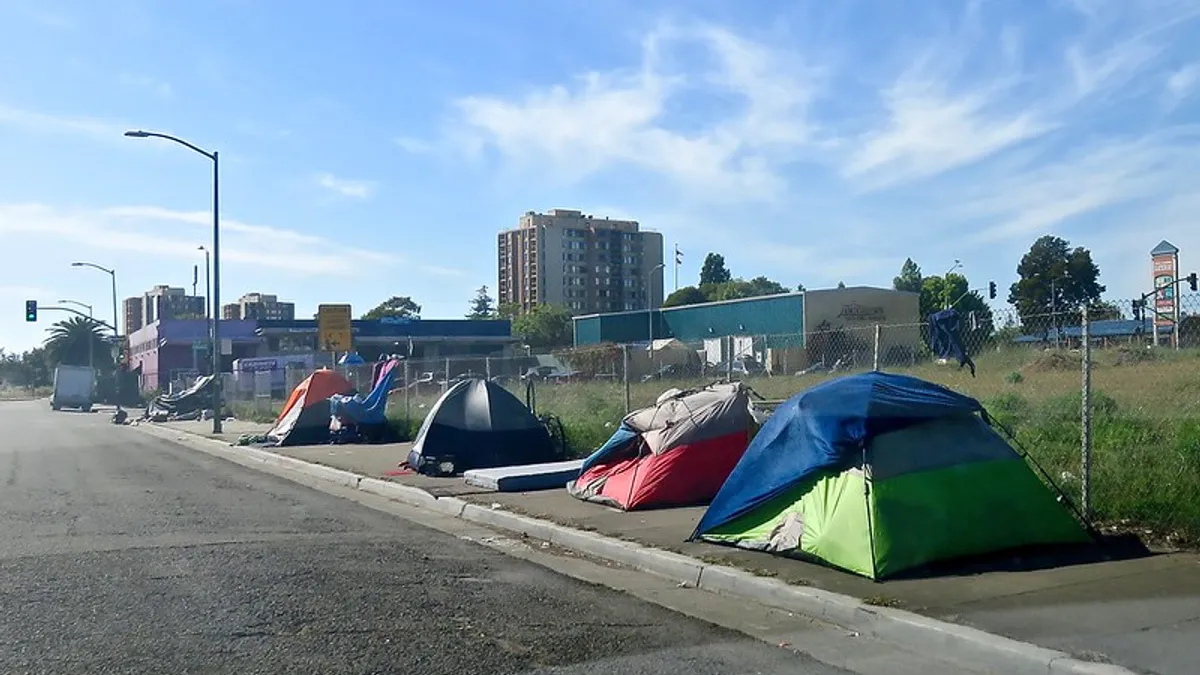Dive Brief:
- As governments prepare for the annual count of people experiencing homelessness, an app is giving cities easier access to data on their unhoused populations.
- Kansas City, Missouri, and Houston are among the cities using apps from Massachusetts-based Simtech Solutions designed to better survey people experiencing homelessness and connect volunteers to aid services. The company’s Counting Us app, which helps volunteers input demographic and location information to the Point in Time (PIT) count, will be used in at least 50 regions, Simtech founder and President Matt Simmons said.
- Ana Rausch, vice president of program operations for the Coalition for the Homeless of Houston/Harris County, said the group has seen more accurate counts and better information since it started using the app in 2016. “It’s brought a lot more validity to our numbers and allows us to see trends that we can respond to,” Rausch said.
Dive Insight:
The U.S. Department of Housing and Urban Development (HUD) requires housing bodies to conduct the PIT count, a snapshot of a single night of the number of people experiencing homelessness, every year in January. The count captures people in emergency shelters, traditional housing, safe havens and those who are unsheltered, although HUD only requires that the unsheltered be counted every two years. Traditionally, Simmons said, the count requires hundreds of volunteers to fan out with paper forms and tally up people they see. The “painful exercise,” he said, could take months to tabulate and might lead to unreliable data if the forms are misread or volunteers miscount people.
“With the app, what would normally take two months can take two days,” Simmons said. “With geolocation and GPS data, we can do reporting by subregion and community. This is actionable data that allows governments to do more to address the causes of homelessness.”
Simtech also produces the Show the Way app, which allows users to capture geolocation data and demographic information and log specific experiences of a person experiencing homelessness. The app uploads the data to a central database to build more support and connect to case managers. After that app was piloted in Houston, San Diego, and Charlotte, North Carolina, it is now active in six communities, Simmons said.
“This is not replacing existing work, this is a better way to capture information so it meets the operational needs of housing providers and case managers,” Simmons said. “We’re thinking about what a person needs and how we can keep that person lifted up and not falling into homelessness again. This is about making it easier to connect to the whole process and network of nonprofits and services.”
According to HUD’s January 2020 PIT count, released in March 2021, 580,466 people in the U.S. were experiencing homelessness on the night of the count in January 2020, up 2.2% from the previous year. As housing affordability continues to be an issue, some cities have looked to technology to help address their growing homeless populations. San Francisco and Seattle, for example, both created apps for citizens to report homeless encampments, which are touted as a way for the city to more rapidly respond with aid. However, critics have called them “snitch” apps that don’t create the services people actually need.
The growth of the Counting Us app comes amid criticism of the PIT count, which some critics say does not give an accurate picture of the full scope of homelessness in the country. A 2020 Government Accountability Office report found that some counts have significant fluctuations from year to year, which “raise questions about data accuracy.” Others have noted that the conditions of the count — which only captures a single day in a year — may miss people who are experiencing homelessness on a different day or might be sheltered somewhere that is not obvious to counters.
In an email, Michael Ullman, coordinator of the National Homeless Information Project, a grassroots group focused on improving homeless services data, said the counts have also been limited by insufficient funding and a lack of quality control. “There’s essentially no money allocated for it,” he said, “so you get what you pay for.”
Rausch, whose organization covers a three-county area around Houston, said that having more information on the homeless population can help her team and local governments better target services. For example, she said, identifying veterans experiencing homelessness through the Counting Us or Show the Way app means volunteers can connect them with existing services for veterans, while responders who focus on youth can be dispatched for younger people.
“This helps us determine the need overall and create strategic planning if we need to increase outreach to a certain area or population,” Rausch said. “This is a no-brainer for us.”











